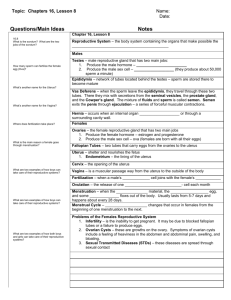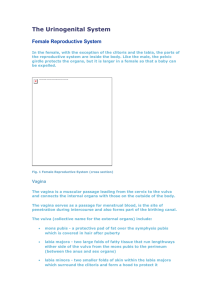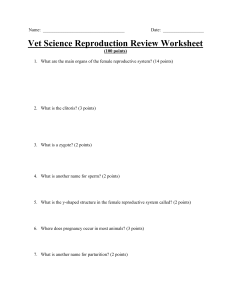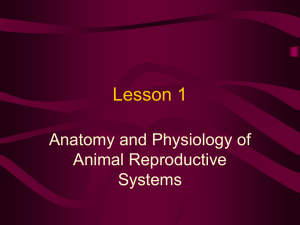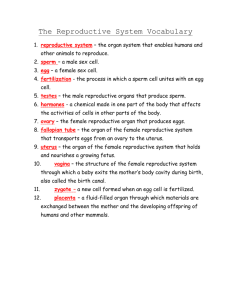English
advertisement
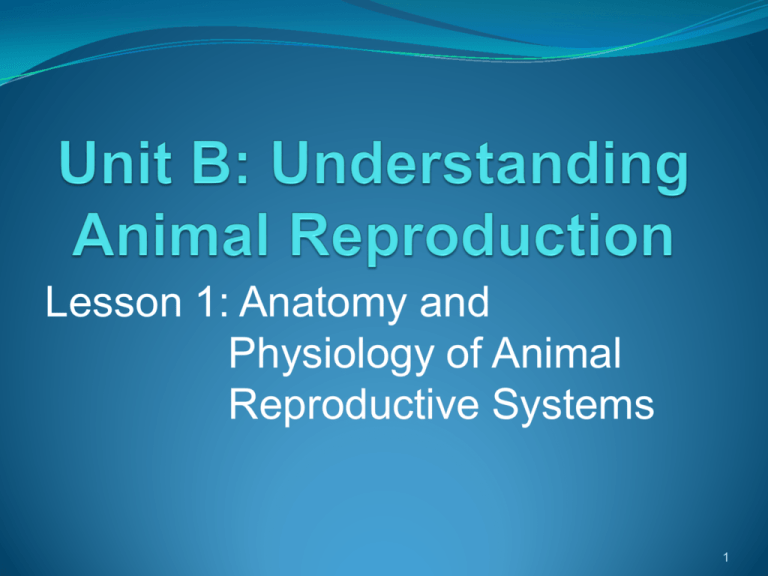
Lesson 1: Anatomy and Physiology of Animal Reproductive Systems 1 Terms Bladder Cervix Clitoris Copulation Cowper’s gland Epididymis Fallopian tubes Follicles Gamete Gestation Infundibulum Labia majora Labia minora Mucosal cells Ova Ovary Oviducts 2 Terms Continued Parturition Penis Prostate gland Retractor muscle Scrotum Semen Seminal vesicles Sheath Sigmoid flexure Sperm Spermatozoa Testicles Testosterone Urethra Urine Uterine horns Uterus Vagina Vas deferens Vulva Zygote 3 What are the major reproductive organs in male mammals? What are the functions of those organs? I. To have a successful livestock operation, a producer must have an understanding of the functions of the various reproductive organs. The male reproductive system contains several interconnected parts that must all work together in order to have successful mating. Some of the major organs found in the male reproductive system are: 4 A. Testicles—The testicles produce sperm, the male sex cells also called spermatozoa. They also produce a hormone called testosterone that causes the appearance and behavior of the animal to be masculine. There are two testicles present in male cattle. 5 Testes—Primary Reproductive Organ of the Bull 6 B. Epididymis—The epididymis is the storage site for sperm cells. These cells enter the epididymis from the testicle to mature. Sperm become able to fertilize a female’s ova or female sex cell, as it travels through the epididymis. There is a separate epididymis attached to each testicle. 7 C. Scrotum-the scrotum is a two-lobed sac that contains and protects the two testicles. It also regulates the temperature of the testicles, maintaining them at a temperature lower than body temperature. When the environment temperature is low, the scrotum contracts. When the environmental temperature is high, the scrotum relaxes Maintaining the correct temperature is critical in that being too hot or too cold can affect the production and vitality of sperm. 8 D. Vas Deferens—The vas deferens is essentially a transportation tube that carries the sperm-containing fluid from each epididymis to the urethra. E. Urethra—The urethra is a large, muscular canal extending from the urinary bladder. Both semen and urine move through the urethra to the end of the penis. F. Accessory Sex Glands—There are several glands that add volume and nutrition to the sperm-rich fluid coming from the epididymis. 9 G. Seminal vesicles—The seminal vesicles open into the urethra. They produce a fluid that protects and transports the sperm. H. Prostate gland—The prostate gland is near the urethra and the bladder. It produces a fluid that is mixed with the seminal fluid. I. Cowper’s gland—The cowper’s gland produces a fluid that moves down the urethra ahead of the seminal fluid. This fluid cleans, neutralizes, and helps protect the sperm through the urethra. The mixture of the seminal and prostate fluid and the sperm is called semen. 10 J. Penis—The penis deposits the semen within the female reproductive system. The urethra in the penis is surrounded by spongy tissue that fills with blood when the male is sexually aroused. This causes an erection that is necessary for copulation, or mating to occur. The sigmoid flexure and the retractor muscle extend the penis from the sheath, a tubular fold of skin. The blood that fills the spongy tissue when sexual arousal occurs causes erection. 11 Reproductive Organs of the Bull 12 What are the major reproductive organs and functions in female mammals? II. Like males, female cattle have a complex system of organs that make up the reproductive system. Some of the major organs that make up the female reproductive tract are: 13 Female Reproductive Organs of a Cow 14 A. Ovary—The ovary produces female gametes. A gamete is a sex cell that can unite with other sex cells. These are called ova or eggs. A female mammal will typically have two ovaries. The ovaries also produce the female sex hormones estrogen & progesterone. Within each ovary there are hundreds of tiny follicles or cavities. The ova are produced in the follicles, the largest single cell in the body. 15 B. Oviducts—The oviducts or fallopian tubes are two tubes that carry the ova from the ovaries to the uterus. The oviducts are close, but not attached to the ovaries. The funnel-shaped end of each oviduct that is close to the ovary is called the infundibulum. At ovulation the follicle ruptures, releasing an ovum that is caught by the infundibulum. After copulation, sperm move through the uterus to the oviduct. Fertilization of the ovum occurs in the upper end of the oviduct. The zygote, or fertilized egg cell, moves to the uterus about 2 to 4 days after fertilization. 16 C. Uterus—The uterus of mammals is a Yshaped structure consisting of the body, two uterine horns, and the cervix. The size and shape of the uterus varies among the various species. The upper part of the uterus consists of the two uterine horns that develop into the oviducts or Fallopian tubes. In most species pregnancy normally occurs in the uterine horns. In all species, the fetus grows within the uterus, where it remains until parturition or birth. 17 The cervix is the lower outlet of the uterus. It is composed primarily of connective tissue that constitutes the gateway between the uterus and the vagina. Like the rest of the reproductive tract, the cervix is lined with mucosal cells. These cells make significant changes as the animal goes from one estrous cycle to another and during gestation or pregnancy. 18 D. Vagina—The vagina serves as the female organ of copulation at mating and as the birth canal at parturition. It is the passage between the cervix and the vulva. The lining is moist during estrus and dry when the animal is not in estrus E. Bladder—The bladder collects the liquid waste, which is called urine. The urine passes through the urethra to the vagina. 19 F. Vulva—The vulva is the external opening of the reproductive and urinary systems. The exterior, and visible part of the vulva, consists of two folds called the labia majora. The labia minora are two folds located just inside the labia majora. G. Clitoris—The clitoris is the sensory and erectile organ of the female. It is located just inside the vulva. 20 Dorsal View of the Reproductive Tract of a Female Cow 21 Review/Summary What are major reproductive organs in male cattle? What are major reproductive organs in female cattle? 22



